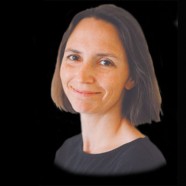
Based on Bainbridge Island, which offers a verdant landscape of woods, ponds, creeks and meadows just a half-hour ferry ride across Puget Sound from Seattle, Frei operates her one-woman forest therapy service called Greet the Wild. Inspired by Shinrin-yoku, the forest bathing practice that originated in Japan in the 1980s, she tailors nature-connection services for individuals and for groups on both private and public walks.
These events, to be clear, are not hikes. And by no means are they bird-counting or plant identification expeditions. Chances are Frei would know the taxonomic classification of the mushroom or butterfly or tree you’d be asking about, but that’s not why she’s taking you outdoors.
“In our culture, we’re used to only just connecting with our brain space and our knowledge and filtering everything through that lens.
“But on a forest therapy walk I’m helping people drop out of this space – ” she taps her forehead, then draws both her hands down in an all-encompassing gesture “ – and into their bodies. It’s more of a sensory immersion.”
On a recent late February afternoon, we are acknowledging the irony that for this interview we’re chatting via Zoom – employing screen time to talk about Frei’s effort to get more people away from their screens and back into nature. But it is a very chilly day (for the Pacific Northwest, anyway), and to hear Frei talk about her love for the outdoors in general, and for her special “sit spot” practice in particular, almost summons the smell of the earth and the sound of the breeze tickling through the branches of nearby trees.
Frei says that on a normal hike, when one is walking or talking with friends, all the regular denizens of the forest go into hiding and wait for the intruder to pass through before re-emerging.
But she adopts a much quieter, slower approach – “I think of it as a deer-browsing rate” – when she leads forest therapy walks. That “sends a message to the forest that we’re not a threat,” Frei claims, and as a result, walk participants are exposed to more of what a forest actually comprises, and are able to open up their senses to new smells, textures, sounds and tastes.
Frei espouses the notion of relationship building with a forest. “The idea is just about being able to get to know your environment. It’s a reciprocal thing – about creating that relationship and also receiving what our bodies are set up to receive from that environment.”
She points out that for most of human history, our nervous systems evolved in out-of-doors settings.
“And this for me is the number one reason it’s always going to be good for us on every level to spend more time outside – that’s our natural environment – every part of our physiology is specifically shaped by the outside world, not the human-built world, so every part of us is built to function at a higher level when it’s plugged into that space.”
In fact, relatively recent scientific studies reveal that phytoncides, the chemical compounds that trees release as protection against diseases and pests, also provide measurable health benefits for humans, from boosting immune responses to reducing inflammation and stress.
In this raggedy exit we seem to be making from the COVID-19 era, it makes sense to augment conventional medicine with these accessible, natural, ages-old remedies.
To further that effort, Frei has joined forces with other guides in the Pacific Northwest who, like herself, have been trained and certified by the Association of Nature & Forest Therapy. The cohort has created a new nonprofit organization, Cascadia Forest Therapy, and adopted a consensus decision-making model to support and grow the practice of forest therapy guiding throughout the bioregion.
It’s fitting that they’ve modeled their human network of mutual assistance on the mycelial underground network established by trees in a forest.
“We work together as a team, share guiding opportunities that come in, and set rates amongst ourselves so it can be economically sustainable and feasible,” Frei says. “This allows us to donate forest walks to underserved communities, so we can offer free walks to people who need it and still pay our guides.”
And that isn’t all.
“We want to make the practice of guiding accessible to anybody from any economic background who wants to be a forest guide,” Frei says.
In this way they hope to restore the relationship between humans and the rest of the natural world.
The Greet the Wild proprietor is optimistic about their prospects. “I think we can all tap into that. It is a healing thing to do.”
Barbara Lloyd McMichael is a freelance writer living in the Pacific Northwest.









